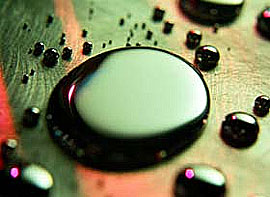Mercury, the molten metal, poses global hazard to humans
People eating seafood fall victims of methyl mercury

People know mercury, the only molten metal and the heaviest liquid in existence since very old times. Now mercury is widely used in all spheres of everyday life: in medicine, photography, agriculture, instrument-making, electrical engineering, electrochemistry and gold-mining. 
Mercury is also known for its toxicity, but today the information about mercury characteristics is undergoing paradoxical transformations. It may occur even under natural conditions that chlorine atoms will be replaced by methyl groups and thus forms dimerhyl-mercury which is even more toxic. Dimerhyl-mercury has been proved to be carcinogenic, neurotoxic, it causes heavy fatigue, drowse, anorexia, headache, nervous disorders, kidney and liver problems, falling out of teeth and hair.
Dimerhyl-mercury is known for its wonderful volatility and non-fixation. In the upper strata of the atmosphere, mercury fume methylate, get combined with any organic substance, go up and soon fall down together with precipitation. Acid rains are the only neutralizer of the poison. When the poison is destroyed, mercury still remains.
Methyl mercury first of all affects water ecosystems and gets settled in the trophic chains of creatures living in lakes and seas. Thus, people eating seafood fall the first victims of methyl mercury. In Canada in 1970 experts for the first time paid serious attention to mass death of Indian tribes who ate only fish. And as a result of the Minamoto Bay catastrophe people living in nearby settlements and eating only seafood died out absolutely all. Researchers discovered that an acetic acid plant located there used mercury in synthesis. Since that time, the mercury concentration index has become the key showing in the fish industry.
A scientific conference on mercury hazard was conducted at Moscow's International Independent Ecology and Political Science University in September.
Doctor of Biology Komov from the Russian Academy of Sciences' Institute for Biology of Inland Waters delivered a report on analysis of mercury content in muscular tissues of fish caught in Russia's north-west and central European parts in 1989-2005. The analysis revealed that in large water reservoirs and some small lakes bigger fish contained more mercury in tissues; at the same time, no dependence between the mercury content and the fish size was registered in majority of small lakes. Doctor of Biology Komov added that a great part of the lakes under analysis are located in poor geochemical areas having no local mercury sources.
Industrial producers should remember that they must be particularly cautious with utilization of out-of-operation mercury switches, equipment and lamps containing mercury. This is one of the factors influencing ecological purity in cities.
Participants of the conference from Russia, Switzerland and the US agreed that it is particularly important today to make the society aware of the mercury threat.
Subscribe to Pravda.Ru Telegram channel, Facebook, RSS!


